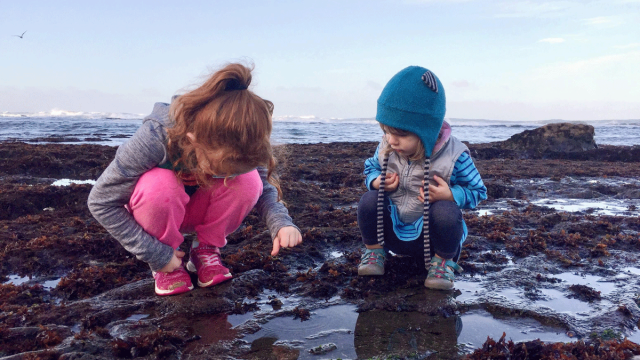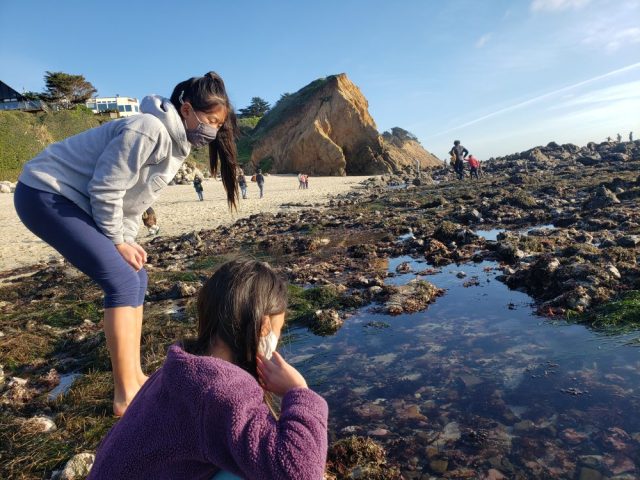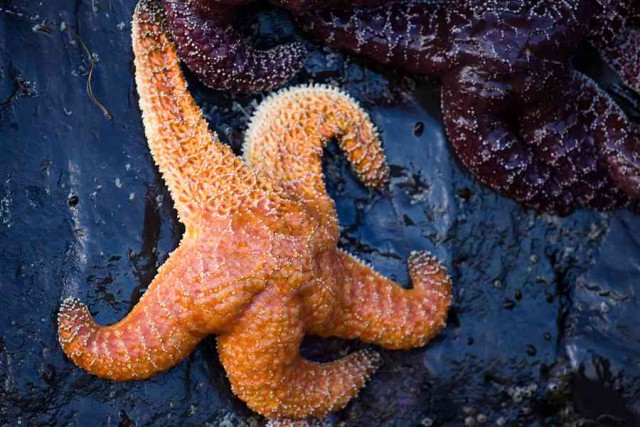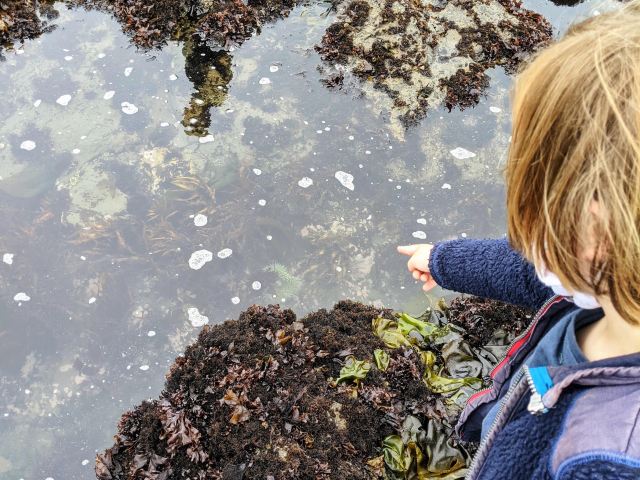If you are lucky, you’ll find sea anemones, sea stars, urchins, and more
Tide pools can almost feel like visiting another world as they reveal parts of nature that are usually hidden making them the perfect way to explore nature with curious kids. With so many so located in the Bay Area and just beyond, it’s always a great day to check out the tide pools. Check the tide schedule, and confirm that the beaches are open (many are under repair after recent storms), pick a time when the tides are the lowest for best viewing, and head off on your next family adventure. Sea anemones, sea stars, crabs, and more are all visible in the pools that are created when the tide recedes. Many of these spots have nearby cliffs with amazing views perfect for whale watching. Grab your crew and ready to explore one of the spots below!
San Francisco
China Beach
Not only is China Beach a great spot for a photo of the kids with the Golden Gate Bridge in the background, but this beach also has a grill and picnic tables (plus bathrooms, yay!) available for public use. The entrance is located on Sea Cliff Ave and at low tide, head down the long flight of stairs to the sand and take a walk along the shore towards Baker Beach to check out the sea anemones, mussels, and sea stars clinging to the rocky crevices. Parking can be tricky so arrive early in the day for the best chance of grabbing a spot in the small parking lot and lease be a good neighbor when parking. More info
Mile Rock Beach at Lands End
Not technically tide pools, the rocky beach at Lands End offers up access to vibrant marine life. The most direct way is to park at the Legion of Honor parking lot, walk along the golf course to Lands End Trail and follow the signs to the Mile Rock Beach stair trail. The hike is well worth it for the beautiful views of Golden Gate Bridge and access to marine life without leaving the city. If you are lucky you may see some whales or sea otters as you walk along the trail at Lands End. More info
East Bay
Crab Cove (Crown Memorial State Beach)
Yes, Alameda has tide pools. Crab Cove Visitors’ Center brings marine and shoreline exploration to the East Bay. Turn off Central Ave. at McKay Ave and you'll find the visitors center where they have aquariums, sea life viewable under microscopes and history about the city of Alameda. Head down to the shore to check out the many crabs, snails and other sea creatures that take up residence in the tide pools there. Accessibility: Beach wheelchairs available with reservation, Accessible bathroom and water fountain currently unavailable. More info
Peninsula and Further South

Fitzgerald Marine Reserve
One of two beaches to explore in Moss Beach, Fitzgerald Marine Reserve has hermit crabs, purple shore crabs, starfish, and brown, thirty-foot-long feather boa kelp. Wildlife includes harbor seals, gray whales migrating in the spring, and brown pelicans in the summer and fall. More info
Seal Cove Beach
Part of Fitzgerald Marine Reserve these tide pools are found by walking down a long staircase from the south entrance off Cypress Ave near the Moss Beach Distillery or from the Reserve parking lot by following the Bluff Trail. This is a great beach for seals and whale watching. More info
Pillar Point
A little further south of Fitzgerald Marine Reserve, this 3-mile stretch of protected beach, tide pools, marshes, and bluffs is a great place to bring the kids (picnic tables and restrooms). Sometimes you can find volunteer naturalists roaming the tide pools who are willing to point out sea urchins, barnacles, sea stars, and more. Check out more tide pools in the area here.

Linda Mar Beach (Pacifica State Beach)
This surfers’ destination is in a protected cove with a great beach for the kids. There is a small creek that empties into the ocean in the middle of the beach—making it perfect for little ones who want to get wet but aren’t interested in the waves. If you are there during low tide, head to the southernmost point on the beach and you’ll come across some great tide pools full of all sorts of crabs and sea anemones. This beach is popular with dog owners so be prepared to share the beach. Parking is $7 for 4 hours of fun $9 for the day, and if you get hungry there’s even a Taco Bell right on the beach. More info
Redondo Beach
Just south of downtown Half Moon Bay, this beach offers beautiful views without the crowds. The easiest access point to the tide pools is to park at the end of Poplar Street at Poplar Beach and then head south along the water about a mile to the tide pools. You can also take the scenic coastal trail along the bluffs above the beach but most of the paths down to the water a steep for kiddos. The walk along the shore takes you right past the Ritz-Carlton. More info
Pescadero State Beach
Between Half Moon Bay and Santa Cruz, you will find Pescadero State Beach which includes three separate parking lots. The middle lot gives you access to the rocky shore and some awesome tide pools where you can spot sea stars and sea anemones a-plenty. There's a restroom here if you need to make a pit stop and they also offer free guided tours of the marshland with registration see website for details. More info
Bean Hollow Beach Trail
South of Pescadero this 1.5-mile hike has free parking, lots of sun, and access to sea life. In addition to wildflowers, you can find sea lions, sea stars, and crabs. More info
Pigeon Point Lighthouse
Just 100 yards north of the hostel at Pigeon Point Lighthouse the tide pools and rocky ledges are only visible during low tide. While you are there check out the lighthouse museum and keep an eye out for whales and sea lions. More info
Natural Bridges State Beach
This beach is great for viewing sea life as well as the naturally formed rock bridge out in the water. Parking is $10, or park just before the beach entrance on Swanton Blvd. for free if there’s a spot. If you head north along the beach you can climb the rocks to access the tide pools. This can be tricky for little ones, so ask at the Visitor Center for directions to get to the pools through the neighboring mobile home park. Also nearby is the Seymour Marine Discovery Center, another great place to learn about Bay Area marine life. More info
Martins Beach
This hidden gem is only accessible from a private road. After multiple court appeals the beach has been declared open to the public. It is possible that the gate will be locked when you arrive but at this time the local sheriff's department has said it will not cite individuals who climb over the gate and walk down the road. Parking is $10, cash only, but you can also park and walk. At high tide, it's a beautiful sandy beach surrounded by bluffs and private homes, but if you are able to come at low tide you can explore the tide pools at the base of the shark fin rock. The shark fin rock has a rock arch that is only visible from the north. More info

Asilomar State Beach Rocky terrain, crystal clear blue water, and tons of sea life inhabit this beach in Monterey Bay. There is ample parking and the beach is even handicap accessible for beach wheelchairs. Watch where you step so that you don't crush the small creatures that reside there. The Point Pinos Lighthouse is a short walk along the coast but the bathrooms are not close by so plan accordingly. More info Point Lobos State Natural Reserve Hiking, wildflowers, and sea life galore are the features of this picturesque area of Carmel. Weston Beach has the best tide pool, just south and west of the main entrance. There's a field guide to the tide pool life that you can take with you. If you are lucky you may spot a sea lion or otter in the waves. Volunteer docents are available to answer questions at the Sea Lion Point parking lot most days from 9 a.m. to 5 p.m. last entry 4:30 In addition to the tide pools you can hike to visit the Whalers Cabin, the small cabin built by Chinese fishermen located on the bluff above Whalers Cove is now a cultural history museum. More info
North Bay and Beyond

Agate Beach
Agate Beach is part of the Duxbury Reef State Marine Sanctuary—the largest soft shale reef in California—which creates an incredibly biodiverse coastal area with whales, sea lions, and many different types of shorebirds. On this 2-mile stretch of beach, a kid exploring the rocky tide pools may come across a giant green anemone which is rumored to measure up to six inches across! Dogs on leashes are permitted. More info
Point Reyes National Seashore
The intertidal zones of the Palomarin Beach and Sculptured Beach are excellent places to explore the animals that enjoy the tides' eternal ebb and flow. Arrive with time to hike as both beaches require a decent walk from the parking area. You will be rewarded by seeing limpets, sand crabs, black turban snails, purple sea urchins, and more. More info
Mackerricher State Park
The tide pools at Mackerricher State Park are a little over three hours north of San Francisco and technically outside of the Bay Area; however, they are worth including if you are up for the longer drive. Located along the Mendocino Coast many of the pools are easily accessible to kids. Before going down to the pools check out the view from the observation platforms along the boardwalk. You will find the tide pools at the bottom of the stairs at Laguna Point. Seals can often be seen along the shoreline, over 90 species of birds visit the area, and whales can be seen from the nearby headland. More info
Remember When Tidepooling:
- Don’t turn your back on the sea—ever. Engrossed in the fascinating sea life, it is easy to lose track of time, and before you know it the tide’s turning.
- Check the tide schedule to make sure you will reach your destination at low tide.
- Wear suitable footwear as barnacles and mussels can often be unforgivingly sharp.
- Watch out for slippery seaweeds and slimy rock areas where it is easy to lose your footing
- Be gentle—Use a two-finger stroke rather than a one-finger poke. If the animal is startled, you may encounter stinging cells or claws.
- If you've moved rocks to look at animals underneath make sure to place them back like before else the sea creature might be too exposed to the elements.
- You can take pictures of sea life and upload it to the California Academy of Science's mobile app iNaturalist, and get help identifying your find.
- Take only pictures and leave only footprints. Try to not disturb the wildlife.
Additional reporting by Kate Loweth, Shruti Priya Bapna, and Gabby Cullen
Need some fresh ideas?
Subscribe to our weekly newsletter for expert parenting tips and simple solutions that make life instantly better.
By subscribing you agree to Tinybeans Terms and Privacy Policy










